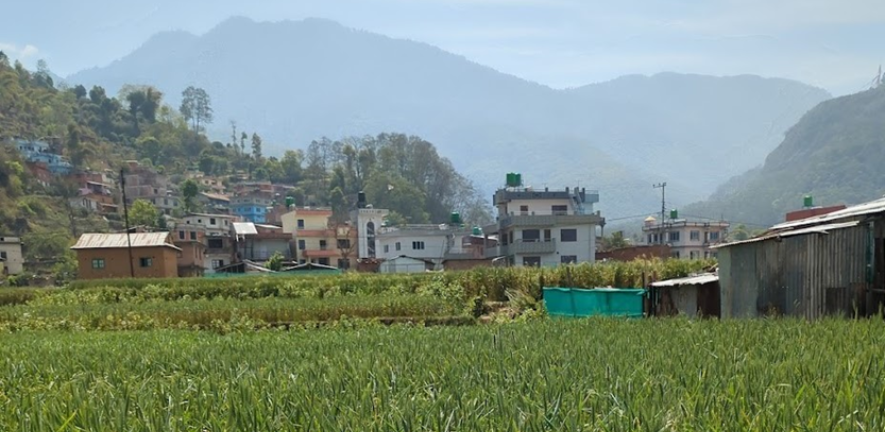
Submitted by Jane Durkin on Mon, 02/09/2024 - 13:22
One of the most serious threats to global wheat producers comes from the airborne spores of fungal pathogens known as wheat rusts (Puccinia spp.). Wheat rusts can devastate harvests across sub-Saharan Africa and southern Asia, threatening food security and livelihoods in regions under pressure from climate change. Early warning forecasting models are crucial for predicting risk levels. They allow national agencies to alert farmers to implement control strategies and prevent crop damage.
Responding to threats from new wheat rust strains, researchers in Plant Sciences have collaborated with partners to develop an Early Warning and Advisory System (EWAS) to protect crops in Ethiopia, Nepal, and Bangladesh. Following this, a new initiative, (Wheat Disease Early Warning and Advisory System (DEWAS), has enabled the team to expand this service to neighbouring countries. The aim is to support over 17 million wheat farmers in sub-Saharan Africa and South Asia by 2026.
The importance of early warning systems for food security
In a review published in the Annual Review of Phytopathology, Chris Gilligan who leads the Epidemiology and Modelling group, presents a global overview of research that has led to the development of sophisticated modelling tools used to forecast wheat diseases. Gilligan explores how the advanced model frameworks incorporate computationally intensive simulations and integrate a suite of models. The framework includes a Lagrangian particle dispersion model, an environmental suitability model, and network analysis, to identify the potential pathways for diseases to spread. The review draws on more than a decade of research by his research team in the Department of Plant Sciences.
Using automated data collection to monitor disease spread
A major challenge with wheat rusts is that they produce millions of spores that can travel in the air across thousands of kilometres. This results in epidemics spreading across international borders.
Automated data collection from on-line sources (‘web-scraping') is a method used for monitoring the spread of human infectious diseases and could be a useful mechanism for tracking plant disease.
In a study published in Climate Resilience and Sustainability, Jacob Smith (Epidemiology and Modelling group) worked with partners to test whether web-scraping could help detect threats from neighbouring countries. They gathered data from web-scraped reports of wheat rust in India and Pakistan and tested if this can be used to predict spore deposition in neighbouring countries such as Nepal and Bangladesh.
Their algorithm showed that west Nepal was exposed to stripe rust spores from India and Pakistan.
The team found that this kind of media sampling is an effective alternative, especially when it is not possible to gathering data on the ground. The paper recommends that policymakers promote international cooperation and coordination in monitoring and managing transboundary plant pathogens like wheat rust.
Transdisciplinary collaboration is key to tackle global challenges like food security
Gilligan’s emphasis on the strength of transdisciplinary partnerships is a testament to the collaborative effort required to address complex global challenges like food security. The wheat rust EWAS involves field surveillance by trained experts who identify new sources of infection, weather-driven dynamic models supported by national and international meteorological agencies and the production and distribution of advisory reports that require agronomic specialists to interpret and communicate risk to growers in near real-time.
This proactive approach to managing the risks associated with wheat rusts is essential in safeguarding the livelihoods of millions of smallholder households and maintaining the stability of the global food supply chain. It’s an excellent example of how science and technology can be harnessed to make a tangible difference in the world.
Text written by Alison Scott-Brown and Jacob Smith from the Epidemiology and Modelling research group at the University of Cambridge.
References:
Gilligan C. (2024), 'Developing Predictive Models and Early Warning Systems for Invading Pathogens: Wheat Rusts', Annual Review of Phytopathology, 62:8.1-8.25 doi.org/10.1146/annurev-phyto-121423-041956
Smith, J. W., Al Faisal, A., Hodson, D., Baidya, S., Bhatta, M., Thapa, D., Basnet, R., Thurston, W., Krupnik, T.J., Gilligan, C. A. (2024), 'Advancing crop disease early warning in South Asia by complementing expert surveys with internet media scraping', Climate Resilience and Sustainability, 3:e78. https://doi.org/10.1002/cli2.78
This research was funded by the Bill and Melinda Gates Foundation and the UK’s Foreign, Commonwealth and Development Office (FCDO).
For more information on research by the Epidemiology and Modelling group please visit Epidemiology and Modelling.
Photo: Nepal, wheat growing district. Image credit: J. Smith, University of Cambridge
